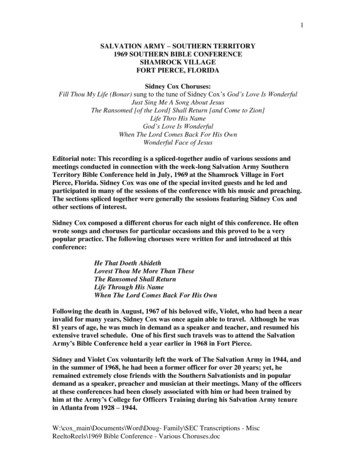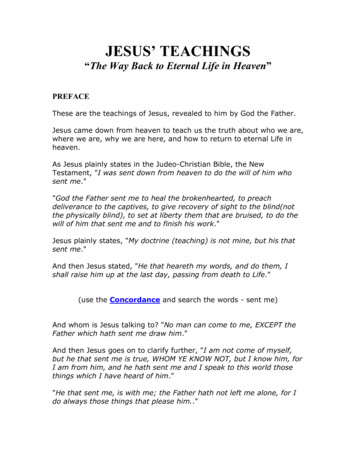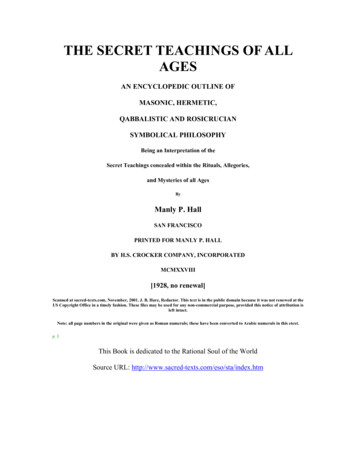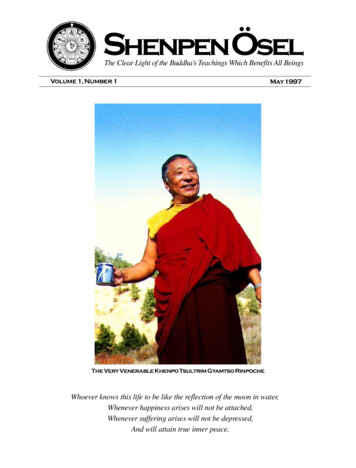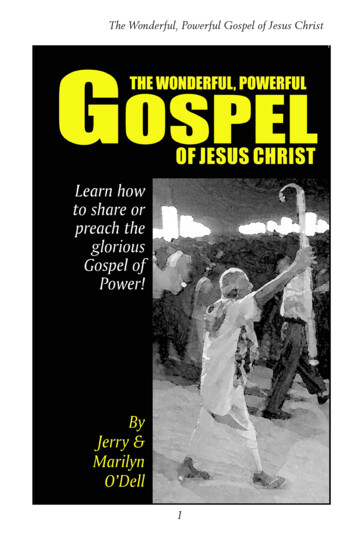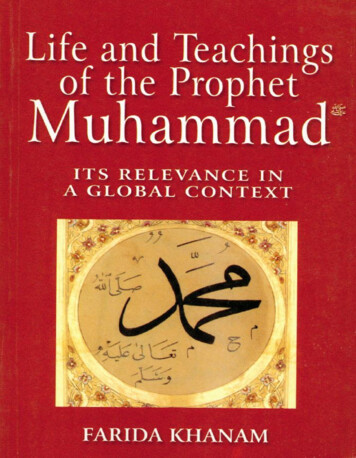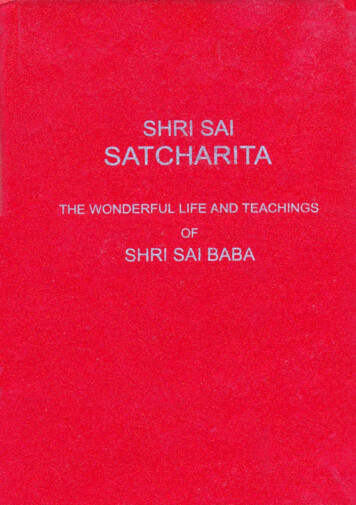
Transcription
THE WONDERFUL LIFE AND TEACHINGSOF SHRI SAI BABAAdapted from the original Marathi BookSHRI SAI SATCHARITABy Govind Raghunath Dabholkar alias 'Hemadpant'In English ByNAGESH VASUDEV GUNAJI, B.A., LLB. 227, Thalakwadi, Belgaum,Published by:Shri Sai Baba Sansthan, Shirdi'Sai Niketan', 804-B, Dr. Ambedkar Road,Dadar, Mumbai - 400 014This Book is available for sale at the following places :(1)Shri Sai Baba Sansthan, Shirdi, P.O.Shirdi, Dist. Ahmednagar.(2)Shri Sai Baba Sansthan, Shirdi,'Sai Niketan', 804-B, Dr.Ambedkar Road, Dadar, Mumbai - 800 014.Copyright reserved by the Sansthan
DEDICATION"Whosoever offers to Me, with love or devotion, a leaf, a flower,a fruit or water, that offering of love of the pure and selfcontrolled man is willingly and readily accepted by Me."— Lord Shri Krishna—in Bhagwad Gita, IX-26TOSHRI SAI BABA THE ANTARYAMIThis work with myself
Life of Shri Nagesh Vasudev Gunaji, B.A., L.L.B. (1876-1963)Shri N.V. Gunaji was an eminent scholar who wroteover twenty eight books on various people and issues.He was avidly interested in the spiritual teachings ofSai Baba, Sri Ramana Maharshi and Sri RamkrishnaParamhansa. He wrote and translated the BhagwadGita, the Bhagwat, etc. He has written the life of SriParamhans Ramakrishna as well as that of Sri RamanaMaharshi in Marathi and several books on theteaching of Swami Ramtirth. He also translatedBooker T. Washington's biography which he called "Atmoddhar".Born in Belgaum in July 1873 in a Saraswat Brahmin family he did hisschool education in Belgaum, in Sardar High School and later graduated fromMumbai's Wilson College. He studied in the Government Law College in Mumbaiand passed his LLB examination. Soon after, he returned to Belgaum to take upthe practice of law. After practising law for several years Shri N.V. Gunaji alsojoined the Belgaum Municipality as Chief Executive Officer. Throughout his lifehe was an avid reader and translated several books in English or Marathi. ShriGunaji was also keenly interested in naturopathy and published two books on"Scientific and Efficient Breathing" and "Anti T.B. & Anti Heart Failure". Hewould treat patients through naturopathy and scientific massage. He also had thegood fortune of treating Mahatma Gandhi by his scientific massage techniqueswhen Gandhiji visited Belgaum several times. Shri Gunaji also treated Sri RamanaMaharshi when he visited the spiritual leader in Arunachalam.Shri N.V. Gunaji adapted and translated Shri Hemand Pant Dabholkar's"Sri Sai Satcharita" into English and donated the entire proceeds to the SaiSansthan Trust. The book has reached out to thousands of devotees and peopleover the last forty five years who have read it and have had their faith andShraddha in Baba reinforced. Many devotees use this book to read it as a 'Saptah'.Shri N.V. Gunaji passed away in 1963, a few months before his ninetieth year.
SHRI SAI SATCHARITACONTENTSChapter1The wondrous Saint grinding wheat - Obeisances - The story ofgrinding wheat and its philosophical significance2Object of writing the work - Incapacity and boldness in theundertaking - Hot discussion - Conferring significant and prophetic title of'Hemadpant' - Necessity of a Guru3Sai Baba's sanction and promise - Assignment of work to the devotees- Baba's stories as beacon-light - His motherly love - Rohila's story - Hissweet and nectar like words4Mission of the saints - Shirdi a Holy Tirth - Personality of Sai Baba Dictum of Goulibua - Appearance of Vitthal - Kshirsagar's story - Das Ganu'sbath in Prayag - Immaculate conception of Sai Baba and His first advent inShirdi - Three Wadas5Baba's return with Chand Patil's marriage party -Welcomed andaddressed as "Sai" - Contact with other saints - His attire and daily routine The story of the Padukas - Wrestling bout with Mohiddin and change in life Turning water into oil - The Pseudo - Guru Javhar All6Efficacy of the touch of the Guru's hand - Ram Navami Festival - Itsorigin, transformation etc. - Repairs to the Masjid7Wonderful Incarnation - Behaviour of Sai Baba - His vogic practices His all-pervasiveness and mercy - Leper devotee's service - MasterKhaparde's plague case - Going to Pandharpur8Importance of human birth - Sai Baba begging food - Baijabai’sservice - Sai Baba's dormitory - His affection for Khushalchand9Effect of compliance and non-compliance with Baba's orders at the time oftaking leave - A few instances -Mendicancy and its necessity - Devotees'(Tarkhad family's) experiences - Baba fed sumptuously10Sai Baba's mode of life - His sleeping plank - His stay in Shirdi - Histeachings - His humility - Nanavali The easiest path11Sai as Sagun Brahma - Dr. Pandit's worship - Haji Siddik Falke Control over the elements12Sai Leelas - Experiences of (1) Kaka Mahajani (2) Dhumal Pleader(3) Mrs. Nimonkar (4) Mule Shastri (5) A Doctor
13More Sai Leelas - Diseases cured (1) Bhimaji Patil (2) Bala Shimpi(3) Bapusaheb Buti (4) Alandi Swami (5) Kaka Mahajani (6) Dattopant ofHarda14Ratanji Wadia of Nanded - Saint Moulisaheb - Dakshina mimansa15Naradiya Kirtan Paddhati - Mr. Cholkar's Sugarless tea - Two Lizards16-17Quick Brahma Gnyan18-19How Hemadpant was accepted and blessed - Stories ofMr. Sathe and Mrs. Deshmukh - Encouraging good thoughts to fruition Variety in Upadesh - Teachings regarding slander and remuneration forlabour20Das Ganu's problem solved by Kaka's maid-servant21Stories of (1) V.H. Thakur (2) Anantrao Patankar and (3) Pandharpurpleader22Rescues from serpent-bites (1) Balasahcb Mirikar (2) Bapusaheb Buti(3) Amir Shakkar (4) Hemadpant - Baba's opinion regarding killing ofserpents23Yoga and onion - Shama cured of snake-bite - Cholera ordinancesbroken - Ordeal of Guru - bhakti24Baba's wit and humour - Chana Leela - (1) Hemadpant (2) Sudama(3) Anna Chinchanikar vs. Maushibai25Damu Anna Kasar of Ahmednagar (1) Speculations (2) Amraleela26Stories of (1) Bhakta Pant (2) Harishchandra Pitale (3) GopalAmbadekar27Favour shown by giving Bhagwat and Vishnu Sahastranaam - Dixit'sVitthal vision - Geeta-Rahasya -Khapardes28Sparrows drawn to Shirdi (1) Lakhshmichand (2) Burhanpore lady(3) Megha29Stories of (1) Chennai's Bhajani Mela (2) Tendulkars (father and son)(3) Dr. Captain Hate (4) Waman Narvekar30Drawn to Shirdi (1) Kakaji Vaidya of Vani (2) Ramlal Punjabi ofMumbai31The passing away in Baba's presence of (1) Sanyaasi Vijayanand(2) Balaram Mankar (3) Noolkar (4) Megha (5) Tiger32In quest of Guru and God - Fasting disapproved
33Greatness of Udi - Scorpion-sting and plague cases cured - Jamnermiracle - Narayan Rao's sickness - Balabua Sutar - Appasaheb Kulkarni Haribhau Karnik34Greatness of Udi (continued) - Doctor's nephew - Dr. Pilley - Shama'ssister-in-law - Irani girl - Harda gentlemen -Mumbai lady35Tested and found not wanting - Kaka Mahajani's friend and master Bandra insomnia case - Bala Patil Newaskar36Wonderful stories of (1) Two Goa gentlemen (2) Mrs. Aurangabadkar37Chavadi procession38Baba's Handi - Disrespect of shrine - Cup of butter milk39Baba's knowledge of Sanskrit - His interpretation of a verse from Gita- Construction of the Samadhi Mandir40Stones of Baba (1) Attending Mrs. Dev's Udyapan ceremony asSanyaasi with two others (2) Hemadpant's house in the form of His picture41Story of the picture - Stealing the rags and reading of Dnyaneshwari42Baba's passing away - Previous indication - Averting death ofRamchandra Dada Patil and Tatya Kote Patil - Charity of Laxmibai Shinde Last moment43-44Baba's passing away (continued) - preparation - SamadhiMandir - Breaking of the brick - 72 hours' Samadhi - Jog's Sanyaas - Baba'snectar-like words45Kakasaheb's doubt and Anandrao's vision - Wooden plank - Baba'sbed-stead and not Bhagat's46Baba's Gaya trip - Story of the two goats47Baba's reminiscences - Story of Veerbhadrappa and Chenbasappa(snake and frog)48Warding off devotee's calamities - Stories of (1) Mr. Shevade(2) Sapatnekar49Stories of (1) Hari Kanoba (2) Soniadev Swami (3) Nanasaheb Chandorkar50Stories of (1) Kakasaheb Dixit (2) Shri Tembe Swami (3) BalaramDhurandharEPILOGUEAARTI
Shri Sai SatcharitraChapter ISalutations -- The Story of Grinding Wheat and Its PhilosophicalSignificance.According to the ancient and revered custom, Hemadpant beginsthe work, Sai Satcharitra, with various salutations.(1) First, he makes obeisance to the God Ganesha1 to remove allobstacles and make the work a success and says that Shri Sai is the GodGanesha.(2) Then, to the Goddess Saraswati2 to inspire him to write out thework and says that Shri Sai is one with this Goddess and that He isHimself singing His own life.(3) Then, to the Gods; Brahma, Vishnu and Shankar - the Creating, Preserving and Destroying Deities respectively; and says that Sainathis one with them and He as the great Teacher, will carry us across theRiver of Wordly Existence.(4) Then, to his tutelary Deity Narayan Adinath who manifestedhimself in Konkan - the land reclaimed by Parashurama3, (Rama in theHindi version) from the sea; and to the Adi (Original) Purusha4 of thefamily.(5) Then, to the Bharadwaja Muni, into whose gotra (clan) hewas born and also to various Rishis, Yagyavalakya, Bhrigu, Parashara,Narad, Vedavyasa, Sanak, Sanandan, Sanatkumar, Shuka. Shounak,Vishwamitra, Vasistha, Valmiki, Vamadeva, Jaimini, Vaishampayan,Nava Yogindra etc, and also modern Saints such as Nivritti, Jnanadev,Sopan, Muktabai, Janardan, Ekanath, Namdev, Tukaram, Kanha, andNarahari etc.1. God Ganesha, a son of Lord Shiva, bears the head of an elephant and the bodyof a human being. When starting anything. He is worshipped by the Hindu.2. Goddess of learning.3. One of the Avtars of incarnations of God (before Lord Rama)4. Man
2SHRI SAI SATCHARITRA(6) Then, to his grandfather Sadashiv, father Raghunath, his mother,who left him in his infancy, to his paternal aunt, who brought him up,and to his loving elder brother.(7) Then, to the readers and prays them to give their whole andundivided attention to his work.(8) And lastly, to his Guru Shri Sainath - an Incarnation of ShriDattatreya, Who is his sole Refuge and Who will make him realize thatBrahman is the Reality and the world an illusion; and incidentally, to allthe Beings in whom the Lord God dwells.After describing in brief the various modes of devotion accordingto Parashara, Vyasa and Shandilya etc., the author goes on to relate thefollowing story:"It was sometime after 1910 A.D. that I went, one fine morning,to the Masjid in Shirdi for getting a darshan of Sai Baba. I waswonderstruck to see the following phenomenon. After washing Hismouth and face, Sai Baba began to make preparations for grinding wheat.He spread a sack on the floor; and thereon set a hand-mill. He tooksome quantity of wheat in a winnowing fan, and then drawing up thesleeves of His Kafni (robe); and taking hold of the peg of the hand-mill,started grinding the wheat by putting a few handfuls of wheat in theupper opening of the mill and rotoated it. I thought- ‘What businessBaba had with the grinding of wheat, when He possessed nothing andstored nothing, and as He lived on alms!’Some people who had comethere thought likewise, but none had the courage to ask baba what Hewas doing. Immediately, this news of Baba's grinding wheat spread intothe village, and at once men and women ran to the Masjid and flockedthere to see Baba's act. Four bold women, fro m the crowd, forced theirway up and pushing Baba aside, took forcibly the peg or handle intotheir hands, and, singing Baba's Leelas, started grinding. At first Babawas enraged, but on seeing the women's love and devotion, He wasmuch pleased and began to smile. While they were grinding, they began to think that Baba had no house, no property, no children, none tolook after, and He lived on alms, He did not require any wheat-flour formaking bread or roti, what will He do with this big quantity of flour?Perhaps as Baba is very kind, He will distribute the flour amongst us.Thinking in this way while singing, they finished the grinding and after putting the hand-mill aside, they divided the flour into four portions and began to remove them one per head. Baba, Who was calm
CHAPTER I3and quiet up till now, got wild and started abusing them saying, "Ladies, are you gone mad? Whose father's property are you looting away?Have I borrowed any wheat from you, so that you can safely take theflour? Now please do this. Take the flour and throw it on the villageborder limits." On hearing this, the women felt abashed and whisperingamongst themselves, went away to the outskirts of the village and spreadthe flour as directed by Baba.I asked the Shirdi people - "What was this that Baba did?" Theyreplied that as the Cholera Epidemic was spreading in the village andthis was Baba's remedy against the same; it was not wheat that wasground but the Cholera itself was ground to pieces and pushed out of thevillage. From this time onward, the Cholera Epidemic subsided and thepeople of the village were happy. I was much pleased to know all this;but at the same time my curiosity was also aroused. I began to ask myself - What earthly connection was there between wheat flour and Cholera? What was the casual relation between the two? and how to reconcile them? The incident seems to be inexplicable. I should write something on this and sing to my heart's content Baba's sweet Leelas. Thinking in this way about this Leela, my heart was filled with joy and I wasthus inspired to write Baba's Life - The Satcharita.And as we know, with Baba's grace and blessing this work wassuccessfully accomplished.Philosophical Significance of GrindingApart from the meaning which the people of Shirdi put on thisincident of grinding wheat, there is, we think, a philosophical significance too. Sai Baba lived in Shirdi for about sixty years and during thislong period, He did the business of grinding almost every day - not,however, the wheat alone; but the sins, the mental and physical afflicationsand the miseries of His innumerable devotees. The two stones of Hismill consisted of Karma and Bhakti, the former being the lower and thelatter the upper one. The handle with which Baba worked the mill consisted of Jnana. It was the firm conviction of Baba that Knowledge orSelf-realization is not possible, unless there is the prior act of grindingof all our impulses, desires, sins; and of the three gunas, viz. Sattva,Raja and Tama; and the Ahamkara, which is so subtle and therefore sodifficult to be got rid of.This reminds us of a similar story of Kabir who seeing a woman
4SHRI SAI SATCHARITRAgrinding corn said to his Guru, Nipathiranjana, "I am weeping because Ifeel the agony of being crushed in this wheel of wordly existence likethe corn in the hand-mill." Nipathiranjana replied, "Do not be afraid;hold fast to the handle of knowledge of this mill, as I do, and do notwander far away from the same but turn inward to the Centre, and youare sure to be saved.Bow to Shri Sai -- Peace be to all
Chapter IIObject of Writing the Work - Incapacity and Boldness in the Undertaking - Hot Discussion - Conferring Significant and Prophetic Titleof Hemadpant - Necessity of a Guru.In the last Chapter, the author mentioned in the original Marathibook that he would state the reason that led him to undertake the work,and the persons qualified to read the same and such other points. Now inthis chapter, he starts to tell the same.Object of Writing the WorkIn the first chapter, I described Sai Baba's miracle of checking anddestroying the epidemic of Cholera by grinding wheat and throwing theflour, on the outskirts of the village. I heard other miracles of Sai Babato my great delight, and this delight burst forth into this poetic work. Ialso thought, that the description of these grand miracles of Sai Babawould be interesting, and instructive to His devotees; and would removetheir sins, and so I began to write the sacred life and teachings of SaiBaba. The life of the saint is neither logical nor dialectical. It shows usthe true and great path.Incapacity and Boldness in Undertaking the WorkHemadpant thought that he was not a fit person to undertakethe work. He said, "I do not know the life of my intimate friend nordo I know my own mind, then how can I write the life of a saint ordescribe the nature of Incarnations, which even the Vedas were unable to do? One must be a saint himself, before he could knowother saints, then how can I describe their glory? To write the lifeof a saint is the most difficult, though one may as well measure thedepth of the water of the seven seas or enclose the sky with clothtrappings. I knew, that this was the most venturous undertaking,which might expose me to ridicule. I, therefore, invoked Sai Baba'sgrace.The premier poet-saint of Maharashtra, Shri Jnaneshwar Maharaj,has stated that the Lord loves those who write the lives of saints; andthe saints also have a peculiar method of their own of getting theservice, which the devotees long for, successfully accomplished. The
6SHRI SAI SATCHARITRAsaints inspire the work, the devotee becomes only an indirect cause orinstrument to achieve the end. For instance, in 1700 Shaka year1, thepoet Mahipati aspired to write the lives of saints. Saints inspired him,and got the work done; so also in 1800 Shaka year,2 Das Ganu's servicewas accepted. The former wrote 4 works-Bhakta Vijaya, Santa Vijaya,Bhakta Leelamrit and Santa Kathamrit, while the latter wrote two "Bhakta Leelamrit and Santa Kathamrit", in which the lives of modernSaints were described. In chapters 31,32,33 of Bhakta Leelamrit and inchapter 57 of Santa Kathamrit, the sweet life and teachings of Sai Babaare very well depicted. These have been separately published in Sai LeelaMagazine, Nos. 11 and 12, Vol. 17; the readers are advised to read thesechapters. So also Sai Baba's wonderful Leelas are described in a smalldecent book named Shri Sainath Bhajana Mala by Mrs. SavitribaiRaghunath Tendulkar of Bandra. Das-Ganu Maharaj also has composedvarious sweet poems on Sai Baba. A devotee named Amidas BhavaniMehta, has also published some stories of Sri Baba in Gujarathi; someNos. of Sainath Prabha, a magazine published by Dakshina BhikshaSanstha of Shirdi, are also published. Then the question of objectioncomes in, that while so many works regarding Sai Baba are extant, whyshould this (Satcharita) be written? and where is its necessity?The answer is plain and simple. The life of Sai Baba is as wideand deep as the infinite ocean; and all can dive deep into the same andtake out precious gems (of knowledge and Bhakti), and distribute themto the aspiring public. The stories, parables, and teachings of Sai Babaare very wonderful. They will give peace and happiness to the people,who are afflicted with sorrows and heavily loaded with miseries ofthis worldly existence, and also bestow knowledge and wisdom, bothin the worldly and in spiritual domains. If these teachings of Sai Baba,which are as interesting and instructive as the Vedic lore, are listenedto and meditated upon, the devotees will get, what they long for, viz.,union with Brahman, mastery in eight-fold Yoga, Bliss of meditationetc. So I thought, that I should call these stories together that wouldbe my best Upasana. This collection would be most delightful to thosesimple souls, whose eyes were not blessed with Sai Baba's darshana.So, I set aboust collecting Sai Baba's teachings and expressions the outcome of His boundless and natural self-realization. It was1. 1700 SA 78 1778 A.D.A.D. 57 Vikrami year2. 1878 A.D.
CHAPTER II7Sai Baba, who inspired me in this matter; in fact, I surrendered my egoat His feet, and thought that my path was clear; and that He would makeme quite happy here, and in the next world.I could not myself ask Sai Baba to give me permission for thiswork; so I requested Mr. Madhavrao Deshpande alias Shama, Baba'smost intimate devotee, to speak to Him for me. He pleaded for my causeand said to Sai Baba, "This Annasaheb wishes to write Your biography,don't say that You are a poor begging Fakir, and there is no necessity towrite it, but if You agree and help him, he will write or rather, Your feet(grace) will accomplish the work. Without Your consent and blessing,nothing can be done successfully." When Sai Baba heard this request,He was moved and blessed me by giving me His Udi (sacred ashes) andplacing His boon-bestowing hand on my head said :- "Let him make acollection of stories and experiences, keep notes and memos; I will helphim. He is only an outward instrument. I should write Myself My autobiography and satisfy the wishes of My devotees. He should get rid ofhis ego, place (or surrender) it at My feet. He who acts like this in life,him I help the most. What of My life-stories? I serve him in his house inall possible ways. When his ego is completely annihilated and there isleft no trace of it, I Myself shall enter into him and shall Myself writeMy own life. Hearing my stories and teachings will create faith in devotees' hearts and they will easily get self - realization and Bliss; let therebe no insistence on establishing one's own view, no attempt to refuteother's opinions, no discussions of pros and cons of any subject."The word ‘discussion' put me in mind of my promise to explain thestory of my getting the title of Hemadpant and now I begin to relate thesame. I was on close friendly terms with Kakasaheb Dixit and NanasahebChandorkar. They pressed me to go to Shirdi and have Baba's darshana,and I promised them to do so. But something in the interval turned up,which prevented me from going to shirdi. The son of a friend of mine atLonavala fell ill. My friend tried all possible means, physical and spiritual, but the fever would not abate. At length he got his Guru to sit by thebed-side of his son, but this too was of no avail. Hearing this, I thoughtëwhat was the utility of the Guru, if he could not save my friend's son?If the Guru can't do anything for us, why should I go to Shirdi at all?'Thinking in this way, I postponed my Shirdi-trip; but the inevitable musthappen and it happened in my case as follows : - Mr. NanasahebChandorkar, who was a Prant Officer, was going on tour to Bassein. FromThana he came to Dadar and was waiting for a train bound for Bassein.
8SHRI SAI SATCHARITRAIn the meanwhile, a Bandra Local turned up. He, sat in it and came toBandra; and sent for me and took me to task for putting off my Shirditrip. Nana's argument for my Shirdi trip was convincing and delightful,and so I decided to start for Shirdi, the same night. I packed up myluggage and started for Shirdi. I planned to go to Dadar and there tocatch the train for Manmad, and so I booked myself for Dadar and sat inthe train. While the train was to start, a Mahomedan came hastily to mycompartment and seeing all my paraphernalia, asked me where I wasbound to. I told him my plan. He then suggested that I should straight goto Boribunder, and not get down at Dadar, for the Manmad Mail did notget down at Dadar at all. If this little miracle or Leela had not happened,I would not have reached Shirdi next day as settled, and many doubtswould have assailed me. But that was not to be. As fortune favoured me,I reached Shirdi the next day before 9 or 10 A.M. Mr. Bhausaheb (Kaka)Dixit was waiting for me there. This was in 1910 A.D., when there wasonly one place, viz., Sathe's Wada for lodging pilgrim devotees. Afteralighting from the Tonga, I was anxious to have darshana, when thegreat devotee, Tatyasaheb Noolkar returned from the Masjid and saidthat Sai Baba was at the corner of the Wada, and that I should first getthe preliminary darshana and then, after bath, see Him at leisure. Hearing this I ran and prostrated before Baba and then my joy knew no bounds.I found more than what Nana Chandorkar had told me. All my senseswere satisfied and I forgot thirst and hunger. The moment I touched SaiBaba's feet, I began a new lease of life. I felt myself much obliged tothose who spurred and helped me to get the darshana; and I consideredthem as my real relatives, and I cannot repay their debt. I only remember them and prostrate (mentally) before them. The peculiarity of SaiBaba's darshana, as I found it, is that by His darshana our thoughts arechanged, the force of previous actions is abated and gradually nonattachment of dispassion towards worldly objects grows up. It is by themerit of actions in many past births that such darshana is got, and if onlyyou see Sai Baba, really all the world becomes or assumes the form ofSai Baba.Hot DiscussionOn the first day of my arrival in Shirdi, there was a discussionbetween me and Balasaheb Bhate regarding the necessity of a Guru.I contended, "Why should we lose our freedom and submit to others? When we have to do our duty, why a Guru is necessary? Onemust try his best and save himself. What can the Guru do to a manwho does nothing but sleeps indolently?" Thus I pleaded freewill,
CHAPTER II9while Mr. Bhate took up the other side, viz., Destiny, and said, "Whatever is bound to happen must happen; even great men have failed, manproposes one way, but God disposes the other (contrary) way. Brushaside your cleverness; pride or egoism won't help you." This discussion,with all its pros and cons went on for an hour or so, and as usual nodecision was arrived at. We had to stop the discussion ultimately as wewere exhausted. The net result of this was that I lost my peace of mindand found that unless there is strong body-consciousness and egoism,there would be no discussion; in other words, it is egoism which breedsdiscussion.Then when we went to the Masjid with others, Baba askedKakasaheb Dixit the following:"What was going on in the (Sathe’s) Wada? What was the discussion about?" and staring at me, Baba further added, "What did thisHemadpant say?"Hearing these words, I was much surprised. The Masjid was at aconsiderable distance from Sathe's Wada where I was staying and wherethe discussion was going on. How could Baba know our discussion unless He be omniscient and Inner Ruler of us all?Significant and Prophetic TitleI began to think why Sai Baba should call me by the nameHemadpant. This word is a corrupt form of Hemadripant. ThisHemadripant was a wellknown Minister of the kings Mahadev andRamadev of Devgiri of the Yadav dynasty. He was very learned, goodnatured and the author of good works, such as Chaturvarga Chintamani(dealing with spiritual subjects) and Rajprashasti. He invented and startednew methods of accounts and was the originator of the Modi (MarathiShorthand) script. But I was quite the opposite, an ignoramus, and ofdull, mediocre intellect. So I could not understand why the name or titlewas conferred upon me, but thinking seriously upon it, I thought that thetitle was a dart to destroy my ego, so that, I should always remain meekand humble. It was also a compliment paid to me for the cleverness inthe discussion.Looking to the future history, we think that Baba’s word (calling Mr. Dabholkar by the name Hemadpant) was significant andprophetic, as we find that he looked after the management of SaiSansthan very intelligently, kept nicely all the accounts and was alsothe author of such a good work "Sai Satcharita", which deals with
1 0SHRI SAI SATCHARITRAsuch important and spiritual subjects as Jnana, Bhakti and dispassion,self-surrender and self-realization.About the Necessity of a GuruHemadpant has left no note, no memo about what Baba said regarding this subject, but Kakasaheb Dixit has published his notes regarding this matter. Next day after Hemadpant's meeting with Sai Baba,Kakasaheb went to Baba and asked whether he should leave Shirdi. BabaSaid, "Yes". Then someone asked - "Baba, where to go?" Baba said,"High up." Then the man said, "How is the way?" Baba said, "There aremany ways leading there; there is one way also from here (Shirdi). Theway is difficult. There are tigers and wolves in the jungles on the way."I (Kakasaheb) asked - "But Baba, what if we take a guide with us?"Baba answered, - "Then there is no difficulty. The guide will take youstraight to your destination, avoiding wolves, tigers and ditches etc. onthe way. If there be no guide, there is the danger of your being lost in thejungles or falling into ditches." Mr. Dabholkar was present on this occasion and he thought that this was the answer Baba gave to the questionwhether Guru was a necessity (Vide Sai Leela Vol. I, No.5, Page 47);and he thereupon took the hint that no discussion of the problem, whetherman is free or bound, is of any use in spiritual matters, but that on thecontrary real Paramartha is possible only as the result of the teachingsof the Guru, as is illustrated in this chapter of the original work in theinstances of great Avatars like Rama and Krishna, who had to submitthemselves to their Gurus, Vasishtha and Sandipani respectively, forgetting self- realization and that the only virtues necessary for suchprogress are faith and patience. (Vide Sai Satcharita, Ch. II, 191-92).Bow to Shri Sai –– Peace be to all
Chapter IIISai Baba's Sanction and Promise - Assignment of Work to Devotees - Baba's Stories as Beacon - Light - His Motherly Love - Rohilla'sStory - His sweet and Nectar - like Words.Sai Baba's Sanction and PromiseAs described in the previous chapter, Sai Baba gave His completeassent to the writing of the Sat-Charita and said, "I fully agree with youregarding the writing of Sat Charita. You do your duty, don't be afraid inthe least, steady your mind and have faith in My words. If my Leelas arewritten, the Avidya (nescience) will vanish and if they are attentively,and devoutly listened to, the consciousness of the worldly existence willabate, and strong waves of devotion, and love will rise up and if onedives deep into My Leelas, he would get precious jewels of knowledge."Hearing this, author was much pleased, and he at once becamefearless and confident, and thought that work was bound to be a success.Then turning to Shama (Madhavrao Deshpande) Sai Bab
service - Sai Baba's dormitory - His affection for Khushalchand 9 Effect of compliance and non-compliance with Baba's orders at the time of taking leave - A few instances -Mendicancy and its necessity - Devotees' (Tarkhad family's) experiences - Baba fed sumptuously 10 Sai Baba's mod

